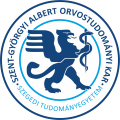Short description of the units of the Department of Physiology
Experimental Neonatology Research Group
Principal investigator:Ferenc Domoki, MD, PhD
Researchers:
Viktória Kovács MS,PhD
Gábor Remzső MSc
Valéria Tóth-Szűki BSc
Our study field is the so-called hypoxic-ischemic encephalopathy (HIE) induced by perinatal asphyxia in term neonates. We focus both on revealing the pathophysiological mechanisms of neuronal-vascular damage leading to HIE and testing promising putative neuroprotective strategies.
To achieve our goals, we utilize a subacute HIE animal model,the newborn pig that is appropriate for clinical translation.
Our research methods involve continuous monitoring of the physiology and cerebral electrical activity of the animals, performing in vivo studies on the cerebrocortical microcirculation and neuronal activity, and analysis of the obtained brain samples using histological and molecular biology techniques.
Sleep research
Lab chief: Lelkes Zoltán, MD, PhD
Translational Behavioral Neuroscience Group
Development and characterization of a complex schizophrenia rat model.
Our laboratory developed a new, complex schizophrenia rat model. The goal of the recent studies to characterize the animals applying different behavioral tests.
1. Investigation of pain threshold of the "schizophrenic rats". 2. Investigation of cognitive functions of the "schizophrenic rats". 3. Investigation of autonomic functions of the "schizophrenic rats".
Lab chief:Gyöngyi Horváth, MD, PhD
Researchers:
Gabriella Kékesi MS, PhD
Alexandra Büki MS,PhD
Leatitia Adlan
Sensory research
Chemosensitive primary sensory neurons expressing members of the TRP receptor family (e.g. the capsaicin receptor) play a central role in the transmission of pain. In the Laboratory of Functional Neuromorphologyl we study the anatomical and functional properties of chemosensitive primary afferent neurons in animal models and neuronal cell cultures under physiological and pathophysiological conditions. We apply behavioural tests, laser Doppler flowmetry and light and electron microscopic functional neuromorphological techniques to examine pain mechanisms and, in particular, nociceptive functions.
Lab chief: Dux Mária MD, PhD
Researchers:
Jancsó Gábor, MD,PhD,DSc
Sántha Péter MD, PhD
Kisné Dobos Ildikó MS
Oszlács Orsolya MS
Tóthné Rosta Judit Mária MS, PhD
Karcsúné Kis Gyöngyi MS, PhD
PhD students:
Pálvölgyi Laura
Dr. Friedrich Nadine
Sensorimotor Research Group
Research topic:
Examination of parallel visual pathways in the mammalian brain.
Electrophysiological and anatomical investigation of multisensory and sensorimotor functions of the ascending tectofugal visual system and the connected basal ganglia in the mammalian brain.
Psychophysical and EEG investigation of visual associative learning in human. Sleep investigation on rats.
Lab chief: Attila Nagy MS, PhD
Lab co-chief: György Benedek MD, PhD, DSc
Researchers:
Balázs Bodosi MS, PhD
Szabolcs Kéri MD, PhD, DSc
Marietta Orosz-Ábel MS, PhD
Kálmán Tót MSc
Ádám Kiss MSc
Diploma students:
András Hegedűs
Márton Gaszner
Bátor Brassó
Bulcsú Szűcs
Viktória Rácz
Olívia Huszár
Noémi Pintér-Harcsa
Scientific partners:
Dr. Gábor Braunitzer
Gabriella Eördegh MS,PhD (ETSZK)
András Kelemen MS,PhD SZTE JGYPK
Péter Gombkötő MS, PhD (Center for Molecular and Behavioral Neuroscience, University Rutgers, USA)
Primate Vision research
Mammalian electrophysiology Extracellular single cell activity recording in the visual and frontal cortices to investigate visually based decision making Human psychophysiology The effects of transcranial DC stimuli on magnocellular-pathway related decisions The organization of the mental lexicon in bilingual individuals The effect of perceptual learning on multimodal processing The investigation of implicit sequence learning using psychophysics and elctrophysiology (EEG)
Lab chief: Sáry Gyula MD, PhD, DSc
Researchers:
Dr. Benyhe András
Dr. Fehér Ágnes, PhD
Péter Kaposvári, PhD
Szemenyeiné Mikite Katalin
Student research associates:
Eperjesi Dávid
Neural Network Research Group
We are investigating the emergent activity patterns of neuronal networks during healthy and pathologic conditions in freely moving animal models. Optogenetic and high-resolution electrophysiological techniques are combined to investigate the network mechanisms during the development of epileptic seizures. We are making attempts to develop a transcranial electrical stimulation approach that can automatically terminate seizures in their early stage through a closed-loop system. Another focus of our work is on the neuronal basis of memory processes and spatial navigation in the hippocampus and related structures. The official language of the lab is English, talented undergrad students with good background in informatics/math/biophysics/biology and good manual skills are welcome.
Lab chief: Berényi Antal, MD, PhD
Researchers:
Nagy Anett
Yuichi Takeuchi
Mari Takeuchi
Qun Li
Rodrigo Alejandro Sierra Ordonez
Ráfi Péter
Student research associates:
Lizeth Katherine Pedraza Correa
Pejin Andrea
Vecsernyés Endre
Barcsai Lívia
Földi Tamás
Langó István
Masahiro Ohsawa PostDoc
Harangozó Márk TDK student
Project manager:
Gyurkovics Tamás BSc
For more information please visit our website at www.berenyilab.com
+36 (62) 545-665,
+36 (62) 544-000/5665

